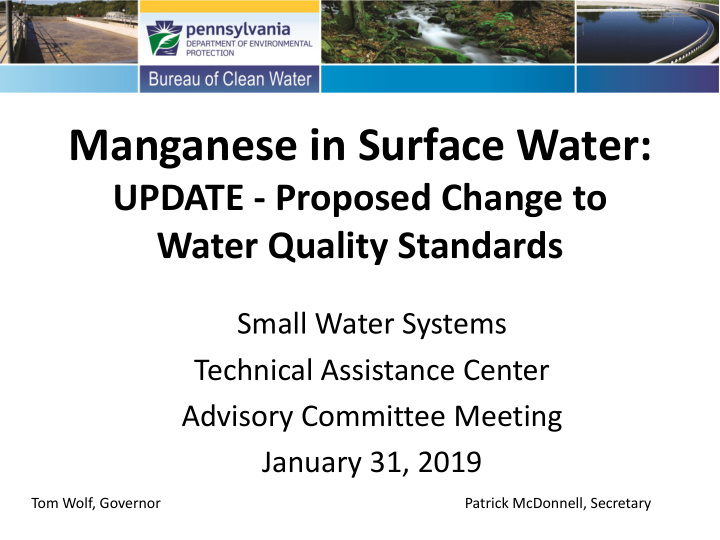



Manganese in Surface Water: UPDATE - Proposed Change to Water Quality Standards Small Water Systems Technical Assistance Center Advisory Committee Meeting January 31, 2019 Tom Wolf, Governor Patrick McDonnell, Secretary
Manganese • Manganese (Mn) is the 12 th most abundant element in the earth’s crust • Manganese is an essential micronutrient, however excessive intake can cause neurological damage to humans • PA DEP currently limits the discharge of manganese to Commonwealth waters to a maximum of 1.0 part per million (1ppm), for taste and odor and to prevent laundry staining
Legislation Adopted On October 30, 2017, the Governor signed PA legislation requiring the Environmental Quality Board (EQB) to promulgate proposed rulemaking to move the point of compliance for the Mn criteria established under 25 Pennsylvania Code (Pa. Code) Ch. 93 from the point of wastewater discharge to the point of Potable Water Supply (PWS) withdrawal; consistent with the special exception in 25 Pa. Code Section 96.3(d).
Must Protect For All Uses Comprehensive Review of Water Quality Standards (WQS) for Mn. DEP develops WQS that protect all water uses by establishing water quality criteria to protect those uses – “ Critical Use .” Protected Water Uses include: • Aquatic Life & Human Health • Water Supply Uses: ❖ PWS = Potable Water Supply ❖ IWS = Industrial Water Supply ❖ LWS = Livestock Water Supply ❖ IRS = Irrigation
What Other States Are Doing Researching available WQS for other states Question asked thru Association of Clean Water Administrators (ACWA) • States replied with Examples of WQ Criteria for: – Human Health – Aquatic Life – Water Supply Uses: • Drinking Water • Agriculture – Aesthetics
Advance Notice Proposed Rulemaking On January 27, 2018, DEP announced an advanced notice of proposed rulemaking (ANPR), seeking public input necessary to prepare this proposed rule for Mn – 48 Pa.B. 605. DEP seeking scientific and economic information to support development of proposed regulations consistent with duties under The Clean Streams Law, the Federal Clean Water Act, and requirements under Commonwealth law regarding the rulemaking process, including the Administrative Code of 1929 and the Regulatory Review Act. Information was received from 13 commenters in response to this ANPR.
Ag Advisory Board DEP met with the Agricultural Advisory Board (AAB) on October 25, 2018 seeking input on the potential impact on agricultural uses, or agriculture-related businesses or operations; and estimates of the direct and indirect costs to these uses, businesses or operations.
Update to Small Facilities TAC DEP interested in knowing from the members of the Small Water Systems Technical Assistance Center (TAC) Advisory Committee: • if the new regulation will have an impact on water supply uses, the users, or the providers; • estimates of the direct and indirect costs on treatment, performance, or costs to the water suppliers or users;
Review of PWS Sample Data Percentage of Sites vs. TMn Avg Concentrations 100% 91% 90% Percentage of Sites 80% 70% 60% 50% 40% 26% 30% 20% 3% 10% 0% > 1000 > 330 > 50 Yearly TMn Avg Concentrations (µg/L) PWS Yearly Mean Total Manganese (TMn Avg , µg/L) 75th 25th Mean Std Dev Median Mode Max Min Percentile Percentile 136 239 66 10 2153 2 29 128 Yearly means of total manganese TMn Avg concentrations (mg/L) measured at potable water Supply (PWS) source monitoring sites between 2014 and 2018, as analyzed from the WQD PWS Assessment dataset. Percentage of sites where the yearly means of total manganese (TMn Avg ) was measured above three concentration thresholds.
Aquatic Life Criteria • EPA currently has no national recommendation on Aquatic Life criteria for Mn. • DEP reviewed criteria for Aquatic Life of Colorado, Illinois, and Michigan. – All three have equation-based criteria that rely on hardness. • DEP believes considerably more research and investigation is needed to determine how useful these states’ criteria would be for Pennsylvania.
Human Health Effects Current science shows manganese is harmful to human health, as a possible nervous system toxin, with implications on early childhood development, at levels that are less than the threshold levels that impact aquatic life Human health criteria needed, and may become the “Critical Use” that provides protection to the other less sensitive uses, at least until such time that a more complete, comprehensive suite of WQ criteria can be developed for the other uses.
Water Supply Use Protection • PA Safe Drinking Water maintains secondary maximum contaminant level (SMCL) for Mn ➢ SMCL’s are enforceable in PA Drinking Water • Concerns with Irrigation / Livestock Water Supply uses • Is there a concern for water supplies for fish hatcheries and water quality for Mn? • What about Industrial Water Supply users, special WQ requirements or pre-treatment needs?
Contact: Tom Barron, tbarron@pa.gov https://www.dep.pa.gov
Recommend
More recommend